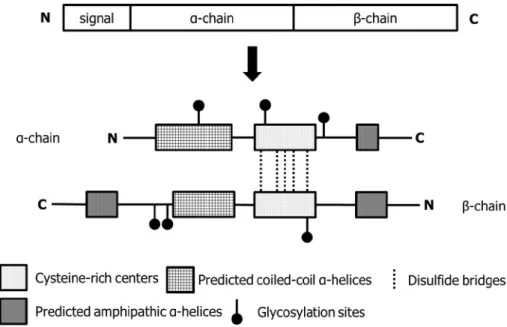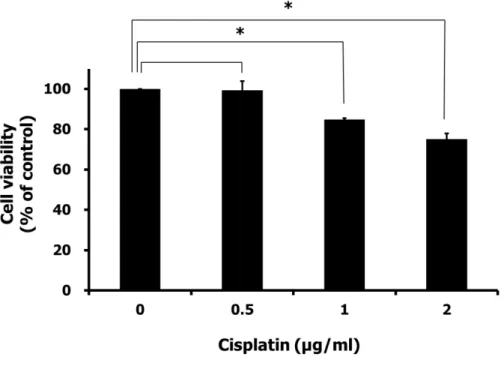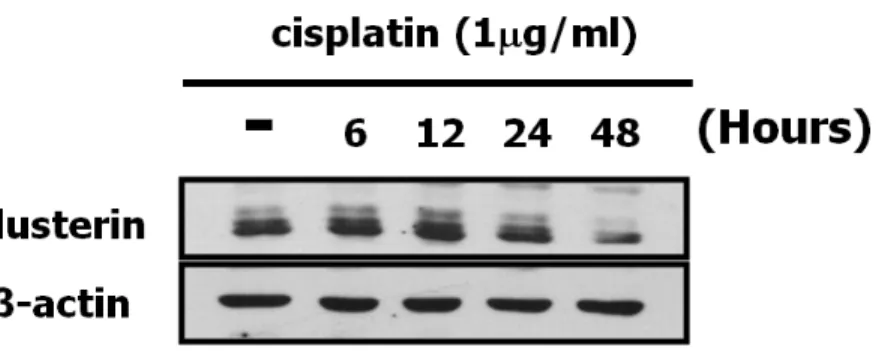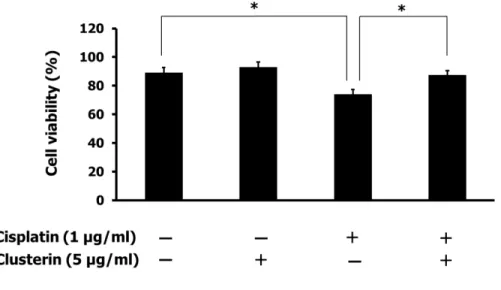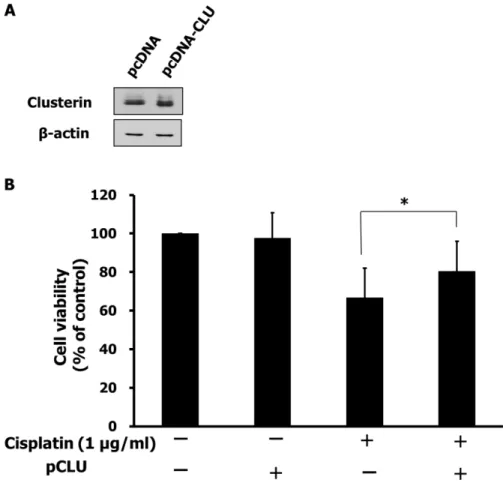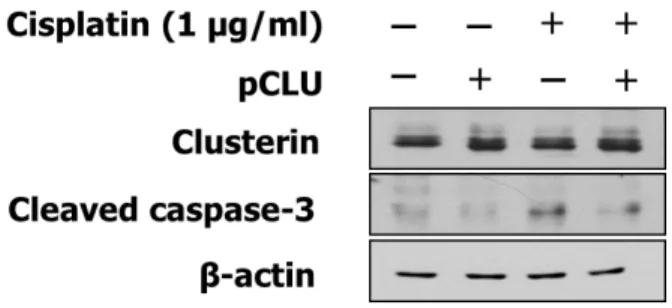저작자표시-비영리-변경금지 2.0 대한민국 이용자는 아래의 조건을 따르는 경우에 한하여 자유롭게
l 이 저작물을 복제, 배포, 전송, 전시, 공연 및 방송할 수 있습니다. 다음과 같은 조건을 따라야 합니다:
l 귀하는, 이 저작물의 재이용이나 배포의 경우, 이 저작물에 적용된 이용허락조건 을 명확하게 나타내어야 합니다.
l 저작권자로부터 별도의 허가를 받으면 이러한 조건들은 적용되지 않습니다.
저작권법에 따른 이용자의 권리는 위의 내용에 의하여 영향을 받지 않습니다. 이것은 이용허락규약(Legal Code)을 이해하기 쉽게 요약한 것입니다.
Disclaimer
저작자표시. 귀하는 원저작자를 표시하여야 합니다.
비영리. 귀하는 이 저작물을 영리 목적으로 이용할 수 없습니다.
변경금지. 귀하는 이 저작물을 개작, 변형 또는 가공할 수 없습니다.
i
Abstract
Clusterin Enhances Cisplatin Resistance of Retinoblastoma
Hyunbeom Song, M.D.
Department of Molecular Medicine and Biopharmaceutical Sciences WCU Graduate School of Convergence Science and Technology Seoul National University
Purpose: Cisplatin is widely used in various chemotherapy regimens for the
treatment of retinoblastoma. Clusterin is cytoprotective chaperone protein that is involved in numerous physiological processes important for tumor growth and carcinogenesis. The expression of clusterin is inversely related with chemosensitivity in several kinds of malignant tumors. The aim of this study is to investigate the association of clusterin with cisplatin resistance of retinoblastoma.
Methods: Clusterin expression was evaluated by immunohistochemical
staining of clusterin in human retinoblastoma tissue. Cell survival analysis of SNUOT-Rb1 cells was done by MTT assay under various concentrations of cisplatin. Clusterin expression under the treatment of cisplatin was measured
ii
by Western blots. To evaluate the effect of exogenous clusterin treatment, SNUOT-Rb1 cells were treated with 1 µg/ml cisplatin in the presence of 5 µg/ml clusterin. SNUOT-Rb1 cells transfected with clusterin cDNA
underwent cell viability assay under the treatment of 1 µg/ml cisplatin. The expression of clusterin and cleaved caspase-3 was measured by Western blots.
Results: In human retinoblastoma tissue, clusterin was diffusely expressed in
the cytoplasm. The expression of clusterin in SNUOT-Rb1 cells increased in a time-dependent manner until 12 h and then decreased. Exogenous clusterin enhanced resistance of SNUOT-Rb1 cells to cisplatin. Upregulation of clusterin by transfection increased cisplatin resistance and resulted in decreased expression of cleaved caspase-3.
Conclusions: High levels of clusterin expression enhance cisplatin resistance
of retinoblastoma. Therefore, clusterin is a potential therapeutic target to chemosensitize retinoblastoma to cisplatin.
Keywords: Clusterin; Retinoblastoma; Cisplatin; Chemoresistance Student Number: 2011-23061
iii
Contents
1. Introduction --- 1
2. Methods --- 4
2.1 Human retinoblastoma tissue --- 4
2.2 Immunohistochemistry --- 4
2.3 Cell cultures --- 5
2.4 Affinity purification of clusterin from human serum --- 5
2.5 Transfection procedure --- 6
2.6 Cell viability assay --- 7
2.7 Western blots --- 8
2.8 Statistical analysis --- 8
3. Results --- 10
3.1 Expression of clusterin in human retinoblastoma tissue --- 10
3.2 Chemosensitivity of SNUOT-Rb1 cells --- 10
iv
3.3 Expression of clusterin in SNUOT-Rb1 cells --- 13
3.4 Effect of exogenous clusterin on chemoresistance --- 13
3.5 Effect of clusterin overexpression on chemoresistance --- 16
4. Discussion --- 19
5. Reference --- 22
6. 국문초록 --- 26
v
List of Figures
Figure 1. Schematic structure of human clusterin --- 3
Figure 2. Immunohistochemical staining of clusterin in human retinoblastoma tissue. --- 11
Figure 3. Chemosensitivity of SNUOT-Rb1 cells. --- 12
Figure 4. Expression of clusterin in SNUOT-Rb1 cells. --- 14
Figure 5. Effect of exogenous clusterin on chemoresistance. --- 15
Figure 6. Effect of clusterin overexpression on chemoresistance --- 17
Figure 7. Effect of clusterin overexpression on apoptosis --- 18
1
1. Introduction
Retinoblastoma is the most common intraocular malignant solid tumor in the childhood.1 Traditionally, external beam radiotherapy or enucleation was the mainstay of treatment, but, in the past decades, systemic chemotherapy has become the primary approach to salvage eyes.2 Primary chemotherapy with or without local treatment was successful in more than 90% of the eyes with group A, B and C retinoblastoma classified by International Classification of Retinoblastoma. However, the treatment success was achieved in only 47% of group D eyes, which exhibit diffuse seeding, and rest of the group needed external beam radiotherapy or enucleation.3 Group E eyes, which are the most extensive stage, are treated by enucleation.4 Eyes with advanced stages are in need of more effective chemotherapy to reduce the tumor volume for local therapy, eventually saving the globes.
Cisplatin (cisdiammine-dichloro-platinum) is widely used in various chemotherapy regimens for the treatment of retinoblastoma.5-7 It interacts with DNA to form DNA adducts leading to intrastrand or interstrand cross-links, which impair proper DNA replication and activate apoptotic pathways.8,9 As shown above, more effective chemotherapy is needed to improve the effectiveness of cisplatin. One of the targets considered for adjuvant chemotherapy is clusterin, because it is known to increase upon chemotherapy10,11 and inhibit apoptosis.12,13 Furthermore, knockdown of clusterin can chemosensitize various cancer cells.14-17
2
Clusterin, also known as testosterone-repressed prostate message-2 or apolipoprotein J, is a sulfated glycoprotein of 75–80 kDa encoded by a single gene of nine exons, spanning over 16 kb on chromosome 8p21–p12.18 The 449 amino acids translated from the clusterin gene undergo maturation process including disulfide bonding, glycosylation and proteolytic cleavage at endoplasmic reticulum and Golgi apparatus, and finally result in the secreted heterodimeric form consisting of α- and β-chains.19 (Fig. 1) Clusterin has been viewed as cytoprotective chaperone protein that is widely expressed in human tissues and is involved in numerous physiological processes important for tumor growth and carcinogenesis includingapoptotic cell death, cell cycle regulation, DNA repair, cell adhesion, tissue remodelling, lipid transportation, membrane recycling, and immune system regulation.14 It has been reported to be overexpressed in several kinds of malignant tumors, and its expression is related with chemoresistance.16,20,21
The role of clusterin in chemoresistance of retinoblastoma has not been studied yet. In the present study, we illustrated that clusterin was overexpressed in the human retinoblastoma tissue and it was induced under cytotoxic stress of cisplatin. We also demonstrated that exogenous supplement of clusterin and its overexpression by transfection enhanced the resistance to cisplatin in retinoblastoma cells.
3
Fig. 1. Schematic structure of human clusterin. The precursor polypeptide chain (top) encoded by a single gene undergoes proteolytic cleavage to remove the 22-mer secretory signal peptide and to generate the α- and β- chains. Disulfide bridges between the cysteine-rich centers link the chains to form a heterodimeric molecule (bottom). Two predicted coiled-coil α-helices, three predicted amphipathic α-helices and six sites of N-linked glycosylation are marked.18
4
2. Methods 2.1 Human retinoblastoma tissue
Enucleated human eye due to retinoblastoma was used in this study. The tissue was harvested from the eight-month-old boy who underwent enucleation due to retinoblastoma in his left eye. He visited our institution to evaluate exodeviation of eyes, and he was diagnosed with bilateral retinoblastoma after dilated fundus examination. After enucleation of the left eye, the fellow eye with retinoblastoma was treated with a systemic chemotherapy regimen consisting of cisplatin, adriamycin, etoposide and cytoxan. The tumor did not respond well to the treatment, so the patient underwent autologous peripheral blood stem cell rescue with high dose chemotherapy.
2.2 Immunohistochemistry
The enucleated eyes were fixed with formalin, embedded with paraffin, and then sectioned (4 μm). The slides were de-paraffinized and incubated with proteinase K at 37˚C. After blocking endogenous peroxidase activity with hydrogen peroxide and blocking nonspecific binding with blocking kit (Zymed Laboratories Inc., South San Francisco, CA, USA), slides were incubated overnight with rabbit anti-clusterin antibody (1:100, Santa Cruz Biotechnology, Santa Cruz, CA, USA) at 4℃, followed by a biotinylated goat anti-rabbit antibody (DAKO, Glostrup, Denmark), revealed by the avidin-
5
biotin complex (Vectastain kit; Vector, Burlingame, CA, USA) and the 3- amino-9-ethyl-carbazole chromogen (AEC, DAKO, Glostrup, Denmark). The slides were mounted Faramount Aqueous mounting medium (DAKO, Glostrup, Denmark) and observed under light microscope (Carl Zeiss, Chester, VA, USA).
2.3 Cell cultures
Human retinoblastoma cell line SNUOT-Rb1, which was established by our group and distinguished from cell line Y79 (American Type Culture Collection, Rockville, MD, USA) by adherent growth and rapid proliferation22, was incubated in RPMI 1640 medium (WelGENE Inc., Daegu, Korea), supplemented with 10% fetal bovine serum (Gibco BRL, Rockville, MD, USA) and 100 μg/mL streptomycin (Invitrogen Inc., Carlsbad, CA, USA) at 37°C in a moist atmosphere of 95% air and 5% CO2. We changed the medium every third day and checked cultured tumor cells daily under a phase-contrast microscope (Carl Zeiss, Chester, VA, USA). If needed, 5 µg/ml of clusterin (BH Min, Korea University, Seoul, Korea) and/or 1 µg/ml of cisplatin (Sigma-Aldrich, St. Louis, MO, USA) were administered.
2.4 Affinity purification of clusterin from human serum
Clusterin was purified from fresh normal human plasma as described in our previous studies, which complied with the Declaration of Helsinki.23-25
6
Human plasma supplemented with 0.5 mM phenylmethylsulfonyl fluoride (PMSF) was precipitated by adding 12% polyethylene glycol (PEG, MW 3350; Sigma-Aldrich) and kept overnight at 4°C. After centrifugation, the supernatant was precipitated again with 23% PEG. The precipitate was subjected to DEAE Sepharose column chromatography (Fast Flow; GE Health Care Life Sciences, Buckinghamshire, UK). Fractions containing clusterin were subjected to heparin Sepharose column chromatography (Fast Flow; GE Health Care Life Sciences). The obtained clusterin was finally purified by affinity chromatography (Cyanogen Bromide-Activated Sepharose 4B; Sigma-Aldrich) covalently conjugated with anti-clusterin monoclonal antibody. The eluted protein was dialyzed and lyophilized before being stored at 80°C.
2.5 Transfection procedure
For transfection the Lipofectamine PLUSTM reagent (Invitrogen Inc., Carlsbad, CA, USA) was used following manufacturer’s instructions. Briefly, 8 µl of PLUS reagent and 5 µg of plasmid DNA (pcDNA-CLU, BH Min, Korea University, Seoul, Korea) were suspended with 487 µl of RPMI 1640 medium without serum and antibiotics (RPMI(−)), and incubated for 15 min at room temperature. 12 µl of Lipofectamine was mixed with 488 µl of RPMI(−). The Lipofectamine suspension was then mixed with the PLUS–pcDNA mixture, and incubated for 15 min at room temperature. The mixtures of 1 ml RPMI(-)
7
containing 5 µg of pcDNA were added to 2.5 × 105 cells and incubated for 3 h at 37°C. Then, medium was changed with RPMI 1640 medium. The time when pcDNA was added to cells were defined as time zero. After 24 hours of induction, cisplatin treatment was done.
2.6 Cell viability assay
Cell viability was evaluated by the 3-(4,5-dimethylthiazol-2-yl)-2,5- diphenyltetrazolium bromide (MTT) assay. SNUOT-Rb1 cells were seeded into each well of 48-well plates at a concentration of 2×104 cells/well. After incubation for 24 hours, cells were treated with various concentrations of cisplatin. After incubation for the following 24 hours, MTT solution was added to each well with final concentration of 0.2 mg/ml. After incubation at 37℃ for 2 hours, the medium was carefully removed, and DMSO was added to solubilize the formazan produced by the viable cells. Optical density values at 540 nm were measured by a microplate spectrophotometer (Molecular Devices, Sunnyvale, CA, USA). Three independent experiments were performed for each experimental condition.
Trypan blue dye exclusion was also used to assess viability of cells after clusterin treatment and clusterin overexpression. Viable cells were counted on a Luna™ automated cell counter (Logos Biosystems, Gyunggi-do, Korea).
Three independent experiments were performed for each experimental condition.
8
2.7 Western blots
Cell lysates were obtained by resuspending cells in radioimmunoprecipitation assay (RIPA) buffer (Tris 50mM pH 7.4; NaCl 150 mM; SDS 0.1%;
NaDeoxycholate 0.5%; Triton X-100 1%; Cell Signaling Technology, Danvers, MA, USA) with a complete protease inhibitor cocktail (Roche Molecular Biochemicals, Indianapolis, IN, USA), incubated on ice for one hour and centrifuged at 20,000×g for 30 min at 4℃. After measurement of the protein concentration using a BCA protein assay kit (Pierce, Rockford, IL, USA), equal amounts of protein from the supernatant were separated by sodium dodecyl sulfate-polyacrylamide gel electrophoresis (SDS-PAGE) using 7% Tris-Tricine gel (Bio-Rad Laboratories, Inc., Hercules, CA, USA) and transferred to nitrocellulose membranes (Amersham Hybond ECL, GE healthcare, Piscataway, NJ, USA). After being blocked with diluted 5% dry skim milk for one hour, the membranes were rinsed and incubated with specific antibodies against clusterin and β-actin in PBS-T (PBS containing 0.1%
Tween-20; Bio-Rad Laboratories, Inc.) overnight at 4℃. The primary antibody was removed by washing the membranes with PBS-T and incubated for one hour with horseradish peroxidase-conjugated secondary antibodies.
2.8 Statistical analysis
Statistical analyses were performed using SPSS software version 18.0 (SPSS Inc., Chicago, IL, USA). P values less than 0.05 were considered to be
9
statistically significant. Figures are depicted as mean ± SD.
10
3. Results
3.1 Expression of clusterin in human retinoblastoma tissue
To check the expression of clusterin in clinical samples, we performed immunohistochemistry using anti-clusterin antibody on tissues from an enucleated human eyeball with retinoblastoma. We cannot tell the tissue was resistant to the cisplatin or not, because it was removed from the host before systemic chemotherapy.
As shown in figure 2, the tissue showed increased expression of clusterin at the tumor, while clusterin was not detectable at normal retina. Clusterin was mainly stained at the cytoplasm.
3.2 Chemosensitivity of SNUOT-Rb1 cells
To investigate the effect of exogenous clusterin on chemoresistance to cisplatin, we performed cell viability assays of SNUOT-Rb1 cells. First, to determine the concentration of cisplatin with sufficient cytotoxicity, MTT assay under various concentrations of cisplatin was done. Under the condition with gradually increasing concentration of cisplatin for 24 hours, at least 1 µg/ml of cisplatin was required to significantly affect the cell viability of SNUOT-Rb1 cells. We determined the concentration with enough chemotherapeutic activity as 1 µg /ml (Fig. 3).
11
Fig. 2. Immunohistochemical staining of clusterin in human retinoblastoma tissue. Human enucleated eye was stained with anti-clusterin antibody. Clusterin was diffusely stained at the area of retinoblastoma (A).
Clusterin was mainly stained at the cytoplasm of the retinoblastoma cells (B), while it was not stained at the area of normal retina (C). Scale bars: (A) 500 µm; (B) and (C) 50 µm.
12
Fig. 3. Chemosensitivity of SNUOT-Rb1 cells. SNUOT-Rb1 cells were treated with various concentrations of cisplatin, and incubated for 24 hours.
Cell viability was measured by MTT assay. Each value represents the mean (±
SD) of three independent experiments (*P < 0.05). At least 1 µg/ml of cisplatin was required to significantly affect the cell viability of SNUOT-Rb1 cells.
13
3.3 Expression of clusterin in SNUOT-Rb1 cells
To investigate the expression of clusterin in retinoblastoma in vitro, we analyzed cell lysates of SNUOT-Rb1 cells with Western blot. As shown in figure 4, clusterin was expressed in SNUOT-Rb1 cells, but we cannot compare the level of expression with other cell lines because chemosensitive or chemoresistant cell lines are not established yet. Since clusterin is known to be upregulated under chemotherapy related stress and acquire chemoresistant phenotype10,11,26, it is needed to investigate the expression of clusterin under chemotherapy related stress in retinoblastoma cells as well. As cisplatin is widely used for the treatment of retinoblastoma, cisplatin was used to induce chemotherapy related stress. Under the treatment of 1 µg/ml cisplatin, clusterin was increased in a time-dependent manner until 12 h and then decreased.
3.4 Effect of exogenous clusterin on chemoresistance
To determine the effect of exogenous clusterin on chemoresistance, trypan blue dye exclusion was done after the treatment of cisplatin and/or exogenous clusterin. The clusterin was administered four hours prior to the cisplatin treatment. As shown in figure 5, cells treated with clusterin did not show significant cell death under cisplatin treatment. This data confirms the cytoprotective effect of exogenous clusterin on SNUOT-Rb1 cells.
14
Fig. 4. Expression of clusterin in SNUOT-Rb1 cells. Western blot analysis for clusterin was performed using β-actin as a loading control. SNUOT-Rb1 cells were expressing clusterin without cisplatin treatment. SNUOT-Rb1 cells were treated with 1 µg/ml of cisplatin for different time conditions (6, 12, 24 and 48 h). Clusterin expression was increased in a time-dependent manner until 12 h and then decreased.
15
Fig. 5. Effect of exogenous clusterin on chemoresistance. Four hours prior to cisplatin treatment, SNUOT-Rb1 cells were treated with 5 µg/ml of clusterin. After cisplatin treatment, cells were incubated for 24 hours. Cell viability was measured by trypan blue dye exclusion. Each value represents the mean (± SD) of three independent experiments (*P < 0.05).
16
3.5 Effect of clusterin overexpression on chemoresistance
To evaluate the effect of clusterin overexpression on chemoresistance, SNUOT-Rb1 cells were transfected with pcDNA-CLU using empty vectors as a control, and underwent cell viability assay. As shown in figure 6 panel A, cells transfected with pcDNA-CLU exhibited increased expression of clusterin. Cell viability assay demonstrated cells overexpressing clusterin showed significantly less cell death under cisplatin treatment (fig. 6 panel B).
Its effect on apoptosis was also evaluated by Western blots. As shown in figure 7, increased cleaved caspase-3 under cisplatin treatment is attenuated in cells transfected with pcDNA-CLU. Thus, clusterin overexpression inhibits apoptosis and enhances resistance to cisplatin.
17
Fig. 6. Effect of clusterin overexpression on chemoresistance. A. After 24 h of induction, cell lysates were prepared for Western blots. Cells transfected with pcDNA were used as a negative control. B. After 24 h of induction, cells were treated with cisplatin. Cell viability assay was performed 24 h after the cisplatin treatment. Each value represents the mean (± SD) of three independent experiments (*P < 0.05).
18
Fig. 7. Effect of clusterin overexpression on apoptosis. After 24 h of induction, cells were treated with cisplatin. 24 h after the cisplatin treatment, cell lysates were prepared for Western blots of clusterin and cleaved caspase-3.
Cleaved caspase-3 was used as a marker for apoptosis and β-actin served as a loading control.
19
4. Discussion
In this study, we demonstrated overexpression of clusterin in retinoblastoma tissue and cisplatin induced expression of clusterin in retinoblastoma cells.
Chemoresistance to cisplatin was enhanced by supplement or overexpression of clusterin. Threrefore, chemoresistance of retinoblastoma is related with clusterin expression, and the knockdown of clusterin could be an adjuvant treatment modality for retinoblastoma.
Clusterin was induced by cisplatin treatment. It is not clear whether it was induced by cisplatin directly or by cytotoxic stress of cisplatin. The details of clusterin expression have not been fully elucidated but one report showed that clusterin expression was repressed by p53.27 However, DNA adducts formed by its interaction with cisplatin activate p53 pathway leading to activation of apoptosis.8 As far as p53 is concerned, clusterin may not be induced by cisplatin directly.
The mechanism of clusterin in enhancing chemoresistance is known to be associated with inhibition of apoptosis, which is consistent with our data on the changes of cleaved caspase-3 expression. Clusterin depletion by small interfering RNA resulted in disruption of the Ku70-Bax complex, activation of Bax and translocation of Bax into mitochondria to induce cytochrome c release and apoptosis.12,13 Overexpression of clusterin increased phosphorylation of Akt and its target protein Bad.19 Down regulation of Bax and enhanced activity of Akt are known mechanisms involved in inhibiting
20
apoptotic signals in cisplatin-resistant tumor cells.8
The association of clusterin with cisplatin resistance was discovered in various studies. Transfection of clusterin gene into human renal cell carcinoma cells enhanced their resistance to cisplatin in vitro and in vivo.28 The administration of clusterin specific antisense oligonucleotides enhanced cisplatin sensitivity of KoTCC-1 human bladder tumor in vitro and in vivo.29 With these preclinical data, clinical studies are underway. Phase II trials of custirsen (OGX-011), a second generation antisense oligonucleotide targeting clusterin, were done in patients with chemotherapy-naive advanced non-small cell lung cancer and metastatic castration-resistant prostate cancer progressing after initial docetaxel therapy.17,30
Further study is needed to demonstrate whether blockade of clusterin with antisense oligonucleotides could induce apoptosis and enhance chemosensitivity of retinoblastoma. In addition, statuses of Bax and Akt need to be evaluated after clusterin overexpression in order to provide evidence on signaling pathways involved in clusterin mediated cisplatin resistance of retinoblastoma.
In the present study, we demonstrated that human retinoblastoma tissue showed increased expression of clusterin. After identification of induced expression of clusterin under cisplatin treatment in retinoblastoma cells, we demonstrated that exogenously given or overexpressed clusterin enhanced chemoresistance to cisplatin. Clusterin could play a role in chemoresistance of retinoblastoma cells to cisplatin and could be used as an adjunctive treatment
21
modality to conventional chemotherapy of retinoblastoma.
22
References
1. Abramson DH. Retinoblastoma in the 20th century: past success and future challenges the Weisenfeld lecture. Invest Ophthalmol Vis Sci. Aug 2005;46(8):2683-2691.
2. Gombos DS, Chevez-Barrios AP. Current treatment and management of retinoblastoma. Curr Oncol Rep. Nov 2007;9(6):453-458.
3. Shields CL, Mashayekhi A, Au AK, et al. The International Classification of Retinoblastoma predicts chemoreduction success.
Ophthalmology. Dec 2006;113(12):2276-2280.
4. Shields CL, Shields JA. Basic understanding of current classification and management of retinoblastoma. Curr Opin Ophthalmol. Jun 2006;17(3):228-234.
5. Varan A, Kiratli H, Aydin B, et al. The treatment of retinoblastoma with four-drug regimen including cisplatin, etoposide, vincristine, and cyclophosphamide. Pediatr Hematol Oncol. Sep 2012;29(6):529-537.
6. Kim H, Lee JW, Kang HJ, et al. Clinical results of chemotherapy based treatment in retinoblastoma patients: a single center experience. Cancer Res Treat. Dec 2008;40(4):164-171.
7. Makimoto A. Results of treatment of retinoblastoma that has infiltrated the optic nerve, is recurrent, or has metastasized outside the eyeball. Int J Clin Oncol. Feb 2004;9(1):7-12.
8. Siddik ZH. Cisplatin: mode of cytotoxic action and molecular basis of resistance. Oncogene. Oct 20 2003;22(47):7265-7279.
9. Rabik CA, Dolan ME. Molecular mechanisms of resistance and toxicity associated with platinating agents. Cancer Treat Rev. Feb 2007;33(1):9-23.
10. Frazzi R, Casali B, Iori M, Nicoli D, Mammi C, Merli F. Increase in clusterin forms part of the stress response in Hodgkin's lymphoma.
23 Int J Oncol. Mar 2011;38(3):677-684.
11. Trougakos IP, So A, Jansen B, Gleave ME, Gonos ES. Silencing expression of the clusterin/apolipoprotein j gene in human cancer cells using small interfering RNA induces spontaneous apoptosis, reduced growth ability, and cell sensitization to genotoxic and oxidative stress. Cancer research. Mar 1 2004;64(5):1834-1842.
12. Trougakos IP, Lourda M, Antonelou MH, et al. Intracellular clusterin inhibits mitochondrial apoptosis by suppressing p53-activating stress signals and stabilizing the cytosolic Ku70-Bax protein complex. Clin Cancer Res. Jan 1 2009;15(1):48-59.
13. Zhang H, Kim JK, Edwards CA, Xu Z, Taichman R, Wang CY.
Clusterin inhibits apoptosis by interacting with activated Bax. Nat Cell Biol. Sep 2005;7(9):909-915.
14. Chen Q, Wang Z, Zhang K, et al. Clusterin confers gemcitabine resistance in pancreatic cancer. World journal of surgical oncology.
2011;9:59.
15. So A, Sinnemann S, Huntsman D, Fazli L, Gleave M. Knockdown of the cytoprotective chaperone, clusterin, chemosensitizes human breast cancer cells both in vitro and in vivo. Mol Cancer Ther. Dec 2005;4(12):1837-1849.
16. Yang GF, Li XM, Xie D. Overexpression of clusterin in ovarian cancer is correlated with impaired survival. Int J Gynecol Cancer. Nov 2009;19(8):1342-1346.
17. Laskin JJ, Nicholas G, Lee C, et al. Phase I/II trial of custirsen (OGX- 011), an inhibitor of clusterin, in combination with a gemcitabine and platinum regimen in patients with previously untreated advanced non-small cell lung cancer. J Thorac Oncol. Mar 2012;7(3):579-586.
18. Jones SE, Jomary C. Clusterin. The international journal of biochemistry & cell biology. May 2002;34(5):427-431.
19. Ammar H, Closset JL. Clusterin activates survival through the phosphatidylinositol 3-kinase/Akt pathway. J Biol Chem. May 9
24 2008;283(19):12851-12861.
20. Watari H, Kanuma T, Ohta Y, et al. Clusterin expression inversely correlates with chemosensitivity and predicts poor survival in patients with locally advanced cervical cancer treated with cisplatin- based neoadjuvant chemotherapy and radical hysterectomy. Pathol Oncol Res. Sep 2010;16(3):345-352.
21. Lourda M, Trougakos IP, Gonos ES. Development of resistance to chemotherapeutic drugs in human osteosarcoma cell lines largely depends on up-regulation of Clusterin/Apolipoprotein J. Int J Cancer. Feb 1 2007;120(3):611-622.
22. Kim JH, Yu YS, Kim DH, Kim CJ, Kim KW. Establishment and characterization of a novel, spontaneously immortalized retinoblastoma cell line with adherent growth. Int J Oncol. Sep 2007;31(3):585-592.
23. Kim JH, Yu YS, Min BH, Kim KW. The role of clusterin in retinal development and free radical damage. Br J Ophthalmol. Nov 2007;91(11):1541-1546.
24. Kim JH, Yu YS, Kim KW, Min BH. The role of clusterin in in vitro ischemia of human retinal endothelial cells. Curr Eye Res. Jul-Aug 2007;32(7-8):693-698.
25. Kim JH, Yu YS, Min BH, Kim KW. Protective effect of clusterin on blood-retinal barrier breakdown in diabetic retinopathy. Invest Ophthalmol Vis Sci. Mar 2010;51(3):1659-1665.
26. Miyake H, Nelson C, Rennie PS, Gleave ME. Acquisition of chemoresistant phenotype by overexpression of the antiapoptotic gene testosterone-repressed prostate message-2 in prostate cancer xenograft models. Cancer research. May 1 2000;60(9):2547-2554.
27. Criswell T, Klokov D, Beman M, Lavik JP, Boothman DA. Repression of IR-inducible clusterin expression by the p53 tumor suppressor protein. Cancer Biol Ther. Jul-Aug 2003;2(4):372-380.
28. Hara I, Miyake H, Gleave ME, Kamidono S. Introduction of clusterin gene into human renal cell carcinoma cells enhances their
25
resistance to cytotoxic chemotherapy through inhibition of apoptosis both in vitro and in vivo. Jpn J Cancer Res. Nov 2001;92(11):1220-1224.
29. Miyake H, Hara I, Kamidono S, Gleave ME. Synergistic chemsensitization and inhibition of tumor growth and metastasis by the antisense oligodeoxynucleotide targeting clusterin gene in a human bladder cancer model. Clin Cancer Res. Dec 2001;7(12):4245-4252.
30. Saad F, Hotte S, North S, et al. Randomized phase II trial of Custirsen (OGX-011) in combination with docetaxel or mitoxantrone as second-line therapy in patients with metastatic castrate-resistant prostate cancer progressing after first-line docetaxel: CUOG trial P-06c. Clin Cancer Res. Sep 1 2011;17(17):5765-5773.
26
국문초록
클러스터린에 의한 망막모세포종의 시스플라틴 내성에 관한 연구
송 현 범 분자의학 및 바이오제약학과 융합과학기술대학원 서울대학교
목적:
시스플라틴은 망막모세포종의 항암치료에 널리 쓰이고 있는 제제이며, 클러스터린은 다양한 악성종양의 내성에 관련되어 있음이 알려진 단백질이다. 본 연구에서는 망막모세포종의 시스플라틴 내성에 클러스터린이 미치는 영향을 알아보고자 하였다.방법:
적출된 사람망막모세포종 조직에 대해 면역조직화학염색으로 클러스터린 발현을 살펴보았다. MTT 분석법으로 다양한 농도의 시스플라틴 하에 SNUOT-Rb1 세포의 생존분석을 시행하였다.시스플라틴 처리에 의한 클러스터린 발현의 변화를 웨스턴법을 통해서 측정하였고, 외인성 클러스터린의 효과를 평가하기 위해 5
27
µg/ml 의 클러스터린 처리 후 1 µg/ml의 시스플라틴을 처리하여 생존분석을 시행하였다. 클러스터린 형질 주입 시행 후 1 µg/ml의 시스플라틴을 처리하여 생존분석을 시행하였고, cleaved caspase-
3의 변화를 웨스턴법을 통해 측정하였다.
결과:
사람망막모세포종 조직에서 클러스터린은 망막모세포종 세포질에 광범위하게 발현되었고, SNUOT-Rb1 세포에서는 시스플라틴 처리에 대해 클러스터린 발현이 처리 후 12시간까지 시간이 갈수록 증가하고 이 후 감소하는 양상을 보였다. 외인성 클러스터린은 시스플라틴에 대한 내성을 강화시키는 것으로 나타났다. 클러스터린 형질 주입 후 시스플라틴에 대한 내성이 증가하고, cleaved caspase-3가 줄어듦을 확인하였다.결론:
본 연구 결과, 클러스터린이 망막모세포종에서 시스플라틴에 대한 내성에 관여하고 있음을 알게 되었다. 따라서, 클러스터린을 조절하는 약제 개발을 통해 망막모세포종의 시스플라틴 감수성을 증가시킬 수 있을 것으로 기대된다.주요어 : 클러스터린, 망막모세포종, 시스플라틴, 내성 학 번 : 2011-23061
